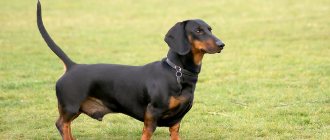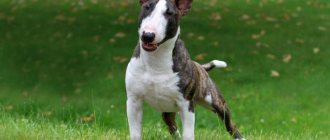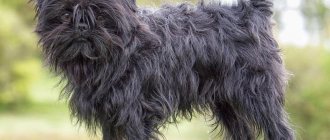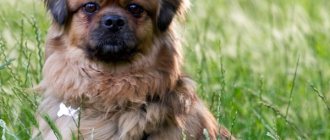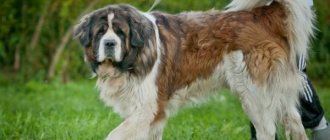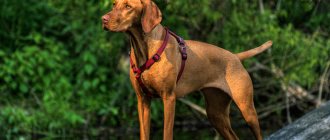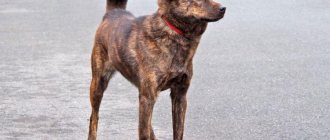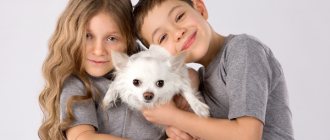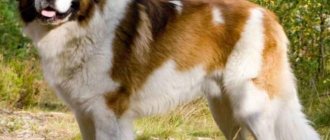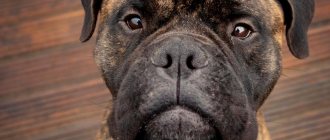History of the origin of the breed
A rare European breed of Greek origin, the Alopekis dates back to the Bronze Age: similar animals were depicted on ancient amphorae (Neolithic finds, 3000 century BC). It is believed that terriers and spitz dogs originated from them. The name comes from the word “alepou” - “fox”. Alopekis, known as the "little fox", has a fox-like appearance.
Together with meliteo kinidio, they led in number in the cities and villages of Greece until the eighties of the 20th century. Later, dogs of other breeds began to be imported into the country and the popularity of native breeds fell; their uncontrolled crossing began. The sterilization of non-breeding animals added to the troubles of the breed, and as a result, the number of Alopekis in Greece fell sharply.
The purity of the breed was also lost. In 2013, only 58 purebred Alopekis were registered at the Thessaloniki Zootechnia Conference. Now they are considered endangered, so even the Greek Kennel Club does not officially register them.
Shepherds, part 2
Shepherd dogs are a general name for dog breeds that were deliberately bred, or that independently, over a long period of time, consolidated their characteristics and characteristics into a separate breed. They served man as an indispensable assistant in grazing livestock. There is no person who would remain indifferent to shepherd dogs. These intelligent creatures never cease to amaze us.
The curious world continues to talk about different types of shepherd breeds.
Pyrenean Shepherd
The Pyrenean Shepherd is a medium-sized herding dog breed originating from the Pyrenees Mountains region of southern France and northern Spain. Used primarily for grazing sheep.
The Pyrenean Shepherd was bred specifically for herding work, and like all shepherds, it has a huge amount of energy contained in a small body. The dog easily adapts to any work in the field, works with desire, it is a born shepherd. The dog needs work, and its high intelligence makes it suitable for both service and active sports such as agility, flyball and obedience. The dog gets along well with children, educates and protects them.
The Pyrenean Shepherd is a one-master dog and is completely devoted to him and is willing to follow him around to help with daily chores. They subtly sense the mood of the owner and are constantly on the alert. Thanks to their attentiveness, they are exceptionally capable of training.
In France, Pyrenean Shepherds gained recognition after World War II for their valiant service as couriers, search and rescue dogs, guard dogs, and mascot companions.
Greek Shepherd
The Greek Shepherd is a dog breed developed in the mountainous regions of Greece and traditionally used by local shepherds to help guard their livestock. It is believed that it originated from the Turkish Akbash breed.
The Greek Shepherd belongs to the group of medium and large breeds and has a strong, developed and muscular body. This dog can handle a wolf alone.
The Greek Shepherd is primarily a working dog. This breed is distinguished by its great endurance and unpretentiousness. This is a loyal, brave and determined “one owner” dog. The Greek Shepherd does not respond well to training based on force and cruelty. It needs consistent training and rigor. Due to its suspiciousness, wariness and aggressiveness, the Greek Shepherd does not interact well with other dogs and people. Even if this dog seems calm, it is ready to rush to protect the charges entrusted to it or the household at any cost. This breed needs puppy socialization as early as possible.
Central Asian Shepherd (Alabai)
The Central Asian Shepherd is an ancient breed of dog from the regions of Central Asia. It is not the result of artificial selection: the aboriginal breed called Alabai is historically common among Central Asian peoples. Used by shepherds, as well as for security and guard duty.
An important feature of the breed: the Central Asian Shepherd can enter into battle only in cases of obvious danger to protected property - property or the owner himself, or when attempting to violate the boundaries of a protected zone. On neutral territory, these dogs are loyal to humans.
Caucasian Shepherd Dog
The Caucasian Shepherd is a dog breed whose region of origin is the Caucasus. It is one of the oldest breeds, existing for more than two thousand years.
Historically, Caucasian Shepherd Dogs were used to protect herds and homes from predators and aggressors. The first mention of the use of large mastiff-like dogs by the troops of the Armenian king Tigran II dates back to the 1st century BC. e.
There are two versions of the origin of Caucasian Shepherd Dogs: according to the canonical version, these dogs descended from the so-called Tibetan Great Danes. In China they were called Tibetan baiting dogs. The first mention of them dates back to 1121 BC. According to the second version, the homeland of these dogs is the ancient state of Urartu. There are images of dogs very similar to Caucasian Shepherds that guarded the cities and fortresses of Urartu. The heyday of this state occurred in the 7th century. BC e., i.e. it can be assumed that these dogs were already in the 7th century BC. e. were in the Caucasus. In 1765, the Caucasian Shepherd was used as a guard dog in the Turkish army.
The Caucasian Shepherd has a persistent, courageous and decisive character. Distrustful of strangers. With sufficient persistence of the owner, it undergoes a general training course and a general course of protective guard service, like any other service breed.
Romanian Carpathian Shepherd Dog
Shepherds of the Carpathian highlands have bred Romanian Shepherds since ancient times. Over the centuries the breed has been improved. The owners purposefully improved it, leaving the strongest and healthiest representatives for breeding. A dog with strong bones, dense muscles, and a short, powerful neck. Thick coat of medium length. The color is usually white with brown speckles, sometimes pure white, sheep are not afraid of white dogs, and such a dog cannot be confused with a wolf. This very strong dog makes a deep impression primarily with its quick reaction and endurance.
The breed is bred in the mountainous regions of Romania. It may have occurred as a result of crossing various herding dogs, probably Slavic and Turkish. They are reliable shepherds and guardians of herds, accustomed to the harsh local conditions. A rare breed, unknown outside its country.
The Romanian Shepherd is aggressive, with a deafening bark (and if necessary, its teeth will be used). This is one of those dogs with which it would rarely occur to anyone to come into conflict. This is, of course, an outstanding guard dog, but it is not a breed that can be kept in an apartment.
Hungarian Shepherd (Komondor)
The size of the Hungarian Shepherd is visually increased due to its fur. The Komondor is very well adapted to work as a sheep herder: thanks to its wool, it camouflages itself in a flock of sheep. Komondors have very light bones, making these shepherds much lighter than other dogs of their size.
Hungarian Shepherds are used as guard dogs; they adapt well to life in urban environments and become very accustomed to their owners.
There is no exact information about the origin of the breed. But the prevailing opinion is that Komondors originally lived in the Black Sea region along with the Magyar tribes, who used them to protect flocks of sheep from predators. About 1000 years ago, they were driven out from there by the Golden Horde to the territory of modern Hungary, where Hungarian Shepherds live to this day.
As for the origin of the breed, scientists believe that the Komondor is the result of crossing several ancient breeds of shepherd dogs and wolves. And the Hungarians have a legend that says that the Komondor appeared as a result of the “marriage” of a wolf and a sheep.
The Komondor is a calm and thorough dog. She has good obedience and quickly learns new skills. The Hungarian Shepherd obeys commands, but, at the right moment, can make decisions itself. Komondors have a highly developed herding instinct, so on the street they tend to herd everyone together and start “herding.”
The best way to train a Komondor is through play.
German Shepherd
The German Shepherd is a breed of dog that was originally used as a herding and detection dog.
The German Shepherd was obtained as a result of selection and crossing of some varieties of herd dogs in Central and Southern Germany. There are smooth-haired and long-haired varieties.
Nowadays, German Shepherds are engaged in a show career, protection, and are also family dogs.
The German Shepherd was developed at the end of the 19th century. The breed owes its official birth to the efforts of the founders of the German Shepherd Lovers Club, headed by Captain Max von Stefanitz, who is rightfully considered the spiritual father of this dog breed.
This is a service dog with a balanced, active type of behavior, capable of a variety of training. The German Shepherd is most successful if it has one owner, but its strength (as a service dog) is that it very easily changes owners and works with new ones with interest. During patrol duty, dogs often, sometimes daily, have to change companions, and here the German Shepherd is beyond competition. She is able to unquestioningly carry out the commands of any policeman with whom she goes on patrol today.
— Smooth-haired German Shepherd
— Long-haired German Shepherd
To be continued…
Description of the breed
The Ancient Alopekis is a primitive breed, in other words, it can be confused with a mongrel. The height of these small dogs (island dwarfism) is only up to 30 cm, they have developed muscles and an elongated, strong body. At the same time, it is quite light: an adult male reaches only 8 kg.
As an unrecognized breed, the Shorthaired Alopekis has only a preliminary standard - a draft, according to which the following characteristics will be fixed.
Head:
- spitz-shaped or “fox-like”, but wide, with a furrow in the middle;
- the muzzle is wedge-shaped, equal in length to the skull;
- lips tightly fitting, jaws strong, scissor bite;
- eyes are large, dark, with dark eyelids, almond-shaped (heterochromia, blue and yellow eyes are unacceptable);
- the ears are mobile, large, triangular, erect (sometimes semi-dropping).
Torso:
- proportional, muscular, slightly elongated (the ratio of the dog’s height to body length is 4:5 - 4:5.5)
- legs of medium length, strong, oval paw prints;
- the tail is usually carried high, but not carried over the back.
Wool:
- smooth, with undercoat, no longer than 5 cm;
- color: white, black and brown monocolors, as well as their combinations, of which the black-red-white tricolor is the most common,
- there may be several spots; albinism is unacceptable;
- soft, thin or sparse wool is a defect.
These are the requirements recorded in the draft breed standard.
In fact, in Greece, all similar animals with short, medium and semi-long hair (small Greek dog), even moderately shaggy ones, with a “beard” and “mustache” are now called alopekis.
Breed dossier
- Country of origin:
Greece - Classification:
not recognized by the FCI. - Training:
Dogs of this breed are loyal and devoted companions, they are easy to train and make excellent helpers. They can compete in dog competitions. Alopekis puppies quickly get used to their owner. - Color:
can be any, but not albino. - Dimensions.
Height at withers: 20-30 cm. Alopekis weight 3-7 kg. - General impression:
Alopekis is a small, cheerful dog, always ready for action. Her limbs are short, but this does not prevent the dog from running tirelessly for many kilometers. - Usage.
Alopekis is a breed of dog bred in Ancient Greece as a universal assistant: watchman, shepherd, hunter. - Physical activity:
Constant physical activity is required. Alopekis loves long walks, traveling and hiking. This dog is well suited for active play sports. - Character:
Representatives of this breed are characterized by innate loyalty, willingness to follow any command, cheerfulness and friendliness. This is a very smart, sociable and playful dog.Obedient, smart, lively, agile, attentive, cheerful and happy in nature, friendly and balanced - all these qualities are characteristic of the Alopekis.
- :
Alopekis dogs are ideal companions, able to quickly adapt to both urban and rural conditions. - Grooming:
No special coat care is required. From time to time you should comb and bathe your dog and trim its nails. - Liveability:
The dog gets along well with other animals. If you train it from puppyhood, then you will treat cats leniently.Alopekis is a loyal dog, she always wants to please her owner and do something nice. He behaves reservedly with children and loves to play catch or catch.
- Diseases:
Incredibly, Alopekis dogs almost never get sick. - Diet:
Unpretentious in food. - Life expectancy:
up to 18 years.
Character and behavioral characteristics
Alopekis, as a breed with ancient roots, has no specialization: it is a watchman, a shepherd, and a hunter. Universal dog. This determines his character - active, non-aggressive, curious, reliable assistant, playful companion, devoted to his owner. Gets along well with pets and children. A dog is a bad neighbor only for rodents, both wild and domestic: it will never make friends with a tame hamster.
A stranger or animal makes her wary, but also a desire to get to know each other. He barks little, but given his size he is quite strong and confident - he can call for help, protect his owner or child. Despite his small stature, he is an excellent shepherd. It is better not to leave Alopekis with children unattended: he may inadvertently push them. These dogs do not tolerate idleness, long-term restrictions on personal freedom and ignoring their needs - they will definitely show cunning and intelligence.
Character
The Greek Shepherd, like many herding dogs of the Balkan Peninsula, has ancient roots. True, dog experts cannot say for sure who exactly was the ancestor of this breed. Most likely, its closest relative is the Turkish Akbash, which was once crossed with the Balkan Molossians.
Interestingly, Greek Shepherds were initially rarely used as herding dogs. Working in pairs, as a rule, the bitch and the dog performed security functions.
Today, the Greek Shepherd is a constant companion of shepherds, and outside of Greece it is quite difficult to meet representatives of this breed, except perhaps in neighboring countries.
By its nature, the Greek Shepherd is a real guard and protector. For her, work and service to people is her life’s work.
As you might guess, this is a dog of one owner, it will obey only him. However, winning the attention and love of a Greek Shepherd is not easy for its owner. Puppies begin to train from early childhood, through play. At the same time, it is very important to carry out socialization on time. Without it, the dog will grow up aggressive and nervous. For example, farmers do not take puppies from the bitch; young animals grow up in a pack, surrounded by a variety of animals.
As for training, only a professional dog handler can cope with the independent character of the Greek Shepherd. Poorly trained dogs can be ferocious and unsociable.
Subscribe to our newsletter and get a free veterinary consultation Thanks for subscribing!
The Greek Shepherd treats strangers with distrust. She issues several warnings and, if the uninvited guest does not stop moving, begins to act. She is capable of making independent decisions.
A Greek Shepherd is not the best babysitter for a child. It is not recommended to leave children alone with these large dogs. Pets will not tolerate familiarity.
The shepherd's relationship with animals largely depends on the character of the neighbor. If the other dog is willing to compromise, the Greek Shepherd is more likely to get along with it. But if a neighbor boldly and persistently tries to dominate, conflict cannot be avoided.
Education and training
They are very smart and try to please people. Training and raising Alopekises is simple: they are not capricious, they have no waywardness. Thanks to the dog’s perseverance and diligence, you can teach it a lot of commands and techniques. For them - any type of dog sport, guarding, herding. He is an average hunter, but he can find and bring game. But it catches rats and mice perfectly.
Activity and cheerfulness remain at a high level until old age. When taking a puppy into your home, decide in advance what you want to make of it. The best way to develop the necessary skills is if you start working with your Alopekis from an early age. If the breed is taken from the street, you will have to overcome some stubbornness during the training process, but this is extinguished by consistent, patient and fair training.
Character and working qualities
An excellent service dog, capable of making quick and independent decisions, but completely focused on its owner. Flexible character, moderately perky, without increased emotionality.
- Patient with children and other pets, loyal and sincere. He will be a wonderful friend and a wonderful comrade.
- Friendly towards strangers, but cautious and observant. Doesn't try to control, but is collected and alert.
- She has a quick reaction and is able to engage in battle with an opponent stronger than herself. Brave and resourceful, capable of acting outside the box. Smart, requires additional classes to develop intellectual activity.
- He loves the training process and works with joy and pleasure. Hardy, calm, efficient. She is emotionally attached to the owner, needs communication, attention, and active games together. Suitable for people even without experience.
- Not picky about care, can be a little stubborn or touchy. He is well versed in facial expressions and intonation.
Diseases and care
A primitive breed on which man has not “worked,” Alopekis is not burdened with genetic diseases. These dogs rarely suffer from common internal diseases and have strong immunity. This is essential for street maintenance. They live on average 12 - 15 years.
The skin protects the dog from heat and cold, but does not get dirty easily. Therefore, brushing once a week and occasional bathing is all that the shorthaired Alopekis coat needs to care for. Don't forget to use dog shampoo. Semi-long-haired dogs take a little more time (twice a week) and effort to brush.
Ear cleaning and nail trimming - if necessary. Alopekises themselves take care of their cleanliness: you will hardly find ectoparasites on them, and caring for their appearance will not require much effort from you.
Health and life expectancy
The breed is relatively healthy, no genetic diseases have been observed. Most likely this is due to the fact that no one ever treated such dogs, so weak dogs simply died, multiplied and only strong individuals survived to this day. At home, such a dog can live up to 15 years, and the average life expectancy is 12 years.
Read Features of the Australian Terrier: maintenance, training, price
Alopekis dogs breed only once a year - this is a feature of the aboriginality of this type. There are most often 3-4 puppies in a litter, rarely 5. Childbirth is easy, the owners of these dogs rarely witness childbirth.
Feeding
Alopekises are not prone to overeating and do not require special feeding; street animals are able to survive even near garbage dumps. You just need to follow the general rules for feeding dogs. An adult dog should be fed twice a day at the same time.
Base her diet on meat (~ 50%) and offal (1 - 2 times a week), porridge, and vegetables. Beef, veal, poultry and horse meat are suitable for alopekis. Give the meat raw, and do not forget to deworm the dog every four to six months, before mating and a week before vaccination. Once a week, replace meat with fish (perch, pike perch, pollock or trout), always boiled and clean. Do not give your alopekis bones or “human” food.
Price and where to buy a puppy
You will not find a breed club or kennel either in Russia or even in Greece, so it makes sense to look for a “purebred” puppy only through the Greek Community for the Rescue and Revival of the Breed or with the help of members of Alopekis fan communities on Facebook and special forums.
If you have the opportunity to travel to Greece, you can personally look there for a dog with a similar appearance and character. Of course, in this case you will not have a guarantee that the puppies will be purebred.
In order to preserve and spread the original Greek dog breed, the Alopekis rescue community most often gives puppies to those who want them free of charge or very inexpensively, but nothing is known about sales to other countries.
Owner reviews
Victoria K.
“People often tell me that my alopekis is the spitting image of a mongrel. I generally agree. But you should have seen how smart and obedient he is! All my doubts about my appearance disappeared when I saw how Toshka was quickly learning all the commands that you could think of.”
Georgy V.
“He eats absolutely everything I give, and at the same time he is healthy. He eats absolutely anything, and if he overdoes it, he dumps excess energy on the very next walk, you can’t stop it. It's like he feels it. My alopeshka is already old, about 10 years old, but not obese, and rushes like a hurricane around the site during walks.”
Alexandra P.
“My Jessie has unique ears: one floppy and one standing. And she is also very affectionate. I come home, and she doesn’t even bark, but squeals like a child with joy and jumps. And at these moments even her drooping ear goes up.”
Similar breeds
Body type: European Spitz, Terrier, Lancashire Heeler, Lapphund.
By height: Beagle, Yorkshire Terrier, Small Poodle, Dachshund, Pug, Schipperke, Manchester Terrier, Sussex Spaniel, Brussels Griffon, Papillon.
By coat length (short-haired): Labrador retriever, beagle, pug, Jack Russell terrier, Brazilian terrier.
By character and working qualities: Labrador, Spitz, Beagle, Dachshund, Shepherd.
By ease of training: Labrador Retriever, Golden Retriever, German Shepherd, Australian Cattle Dog, Welsh Springer Terrier, Sheltie, Beauceron.
Briefly about the main thing
- This is the oldest European breed (type of dog) of Greek origin.
- Outwardly primitive, ordinary, but have a wonderful disposition.
- Thanks to natural selection, Alopekises are very healthy dogs with high immunity.
- They reproduce slowly due to small litters and high mortality of puppies.
Are you looking for a loyal dog friend? Write to us, did this article help you make a choice?
Did you like the article? Share it with your friends on social media. networks. This will help them get useful information and support our project.
